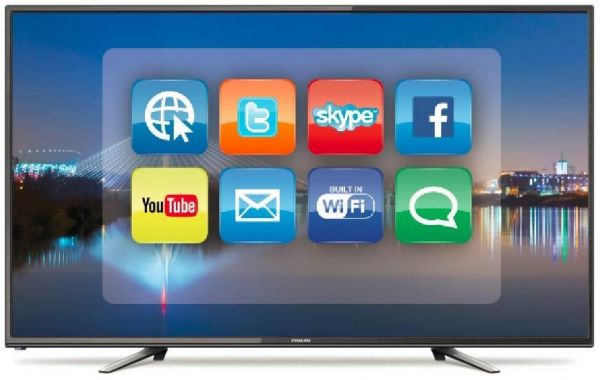We are living in an era, where technology automates operations and reduces the processing time by interconnecting devices. OTT (Over the top media services) and Smart TV application development enhances the user engagement with automated services such as streaming, voice control, etc. which increases the customer experience. This has led to the increase in demand of Smart TV app developers as with internet of things (IoT), the usage of Smart TVs becomes easier and makes everyday life comfortable too.
According to Business Insider, Smart TVs hold 38% of the digital technology market and it is only going to increase more in the future.
Almost everyone loves Netflix, the binge watching feel never gets older. What is better than sitting cozy and enjoying the streaming in Smart TVs across multiple platforms with a simple mobile app control?
Smart TV Application Development For Multiple Platforms
Lets understand the fast Smart TV applications and the furious development for multiple platforms. Smart TV application development is one of the hot applications of IoT Development.
Today developers leverage Smart TV application development developers because of the multiple platform availability. Users have the ability to choose a platform they prefer but each platform operates differently. Following are some of the multiple platforms:
- Android TV
- Apple TV
- Amazon Fire Stick
- Samsung Tizen, etc.
In order to build an efficient Smart TV mobile application you have to follow a set of guidelines to ensure glitch-free performance and enhanced user experience in return. This article discusses about some of the important approaches to follow in leveraging Smart TV application development for multiple platforms.
Key Tips To Be Considered While Developing Smart TV Application Development For Multiple Platforms

Choose the appropriate technology stack
Each Smart TV operates on a different platform. So, same tools may not be compatible for all the platforms. There are tools that are expensive and then there are tools that are cheap. First gather the requirements to meet and the budget you have to stick to.
After gathering these requirements, validate all tools and software development kits to see if they are comprehensive enough to execute the functions you are trying to develop without any hassle. These tools include, XCode, JAVA, AJAX, android development tools (ADT), etc.
Using emulators is not a smart choice
Emulators are software with in-built simulation. Do not use them for developing Smart TV mobile applications because they come with in-built features and functions. These in-built features and functions may not be appropriate for Smart TV development. This is because emulators do not support keyboard control and checking network performance is not possible too. This is a major drawback as Smart TVs work via network support to offer different services like streaming, video-calling, etc.
Cross verify with platform guidelines
Each platform store has its own set of rules and regulations that your Smart TV mobile application should meet in order to be deployed. After development and successful testing, check whether your Smart TV mobile application meets all the rules and regulations set by the platform store. Also, ensure that your Smart TV mobile application satisfies the guidelines set by the platform store.
Better choice would be to develop Smart TV mobile application after going through the complete guidelines and cross verifying with those guidelines at each stage. This increase the chance of your Smart TV mobile application to be deployed by 50%.
Not all scenarios can be predicted
There are unforeseen factors that may affect the performance of the Smart TV mobile application. This may be due to natural climatic factors or low network performance. During such occasions, your Smart TV app may glitch or abruptly close or just freeze. These may lead to dissatisfied customers if these occasions are not handled in the right approach. The right approach of handling them includes notifying the customer of the functional issue and asking them to patiently wait for it to get fixed.
When there is low network, let users get notified through in-app or push notifications that their network is poor and the app may underperform due to it. In the case of natural climatic factors, notify users with a proper error message that will be displayed on the screen. For example, in the case of heavy rain, notify users that “Dear user, your services will resume in a short while. Heavy rains affect the inter-connectivity” or so. Ensure that the Smart TV mobile app works fine even with just a 2G network. That should be your minimum viable product (MVP).
Focus on the core functions for developing attractive user-interface
Developers and clients sometimes mistake Smart TV app with a normal mobile app. A Smart TV must cut to the chase and adherent to the purpose it serves. Ensure that you do not develop and include features more than needed. Keep it simple and elegant with soothing colours and attractive designs.
As a developer, you should also understand that, different platforms perform differently with each design. A Smart TV with 8K resolutions will underperform in a Smart TV app if it does not support 8K resolution and designs. So, make sure that your Smart TV app designs are in-line with the resolution of the Smart TV it is connected with. Make all content understandable and readable.
Important Key Steps To Follow In Developing Smart TV Application For Multiple Platform
Step one: Application design
Gather requirements, create prototypes to understand the functionality to ensure there is no point of failure. Ensure that the design is simple, understandable and unique with pleasing visuals.
Step two: Application development
Be intuitive and cross verify your Smart TV application performance with the intended Smart TV resolution, environment guidelines and variables of the respective platform, etc. Ensure the inter-connectivity between devices is strong and seamless.
Step three: Application testing
At every stage, test and check your Smart TV application for quality, endurance and performance. Any test that provides a result of lower than minimum quality, make sure to re-engineer or re-develop the particular operation or the entire application based on the error consequence.
Step four: Application Maintenance
This is most important step of all. At set interval period of time, keep monitoring and maintaining your Smart TV app for bug fixing. Also, ensure glitch-free operation while bug fixing. Have a team that monitors the Smart TV application for any downtime to make sure that there is no bug that hinder the continuous functionality.
Conclusion: Smart TVs today are transforming close to computers
Computers may have complicated functionalities and features but a Smart TV is supposed to work in a simple manner even if it uses complicated hardware. This is because there are different kinds of users and all users may not understand complicated functionalities. Keep it simple and provide easy navigation with an instant finger touch feature or what you deem appropriate.
A good Smart TV application increases the viewership and also expands your business brand. Quoting stranger things to our purpose, “your Smart TV application should be stealthy, like a ninja”. Good Luck.




